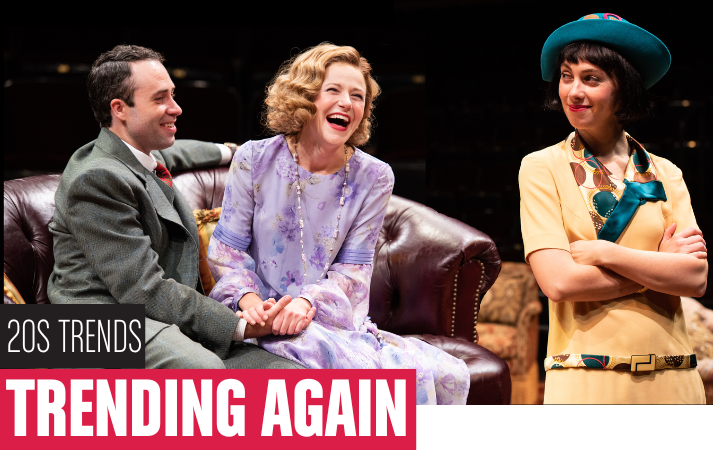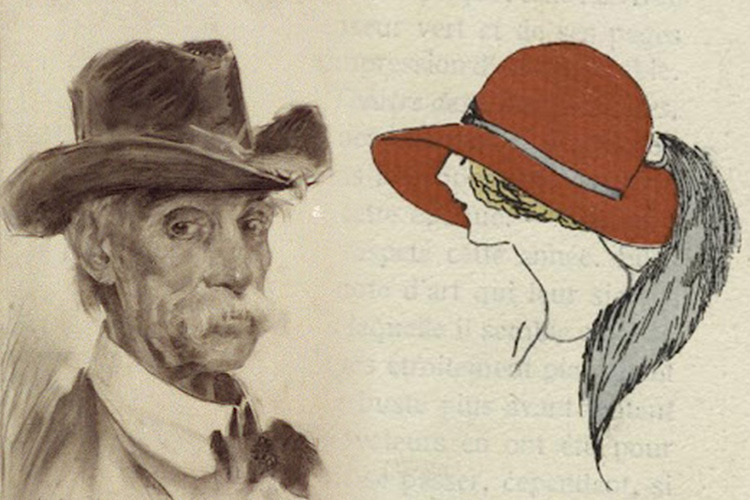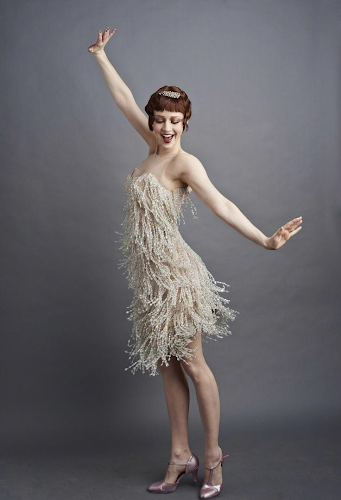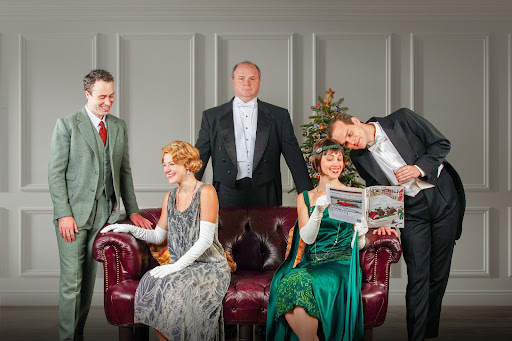
Our production of Holiday is set in the lush and fabulous 1920s. We couldn’t help but wonder how fashion has changed in the 100 years since Philip Barry wrote this incisive romantic comedy. What styles are currently obsolete and which trends are trending again?
Post-Wartime

When World War I ended in 1918, after being forced to scrimp and save during wartime, American creativity flourished. High fashion was finally attainable for the middle class! This was not due to the aristocracy lowering their prices for clothing, but because advertising and manufacturing took a new approach.
In the 1910s, women’s clothing used large portions of fabric and yardage in their styles. By mass manufacturing clothing during WWI, manufacturers discovered that styles using less fabric were cheaper to produce; as a result, dyes, textiles, and patterns became accessible to everyone. Advertising focused on selling the “ready-to-wear” fantasy—hiding the harsh reality of sweatshops and factories making the clothes. For the first time, ads showed full outfits, styled and worn by beautiful women, ready to be worn by YOU.
Think of any fast-fashion clothing brand: ASOS, H&M, Forever 21, etc.–ready-to-wear fashion modeled by gorgeous models. We have 1920s advertisers to thank! It’s funny how high-brand clothing sells MORE for hand stitching one-of-a-kind works while ordinary brands sell for LESS in mass-manufactured materials today. How times have changed!
Back to the 1920s, full outfits could be sold by stores instead of displaying the fabrics to be made at home. If you were in the lower class, you gained the opportunity to buy AND make your own clothes! In the city, young and trendy ladies were eager to try new silhouettes and designs to see what they could get away with. Ladies in rural areas were just fine with sticking with what their mothers wore. Mom jeans, anyone?
Silhouette
The most common trend throughout the 20s is dresses and coats with a strikingly straight silhouette. In other eras, there was some kind of accentuation to figure; the 20s stands out for this particular choice. More than 100 years later, we also seem to be leaning towards this lack of figure; today, Gen Z clothing steps away from skinny jeans and fitted materials. The desire for apparel in Gen Z is to be comfortable in loose T-shirts and cargo or baggier pants that obscure the figure.
For men, suits were still in style (because a suit, gentlemen, is timeless), but manufacturers used softer fabrics with looser fits. Shoulder pads were removed to get rid of the boxy silhouette; instead, the jackets were more form-fitting with a sloped shoulder. Tailored suits became popular to show off the figure with cuffed pants. This made a stronger, more defined silhouette. Interesting how men showed off their figures more than the females at this time! Talk about a hot boy summer.

Hats and Headwear
Hats may be an optional choice for the 21st century, but in the 1920s they were a staple. There were many choices of style for women—less for men, sadly. Men’s fashion wasn’t too flamboyant at the time; nor was it ever really expressive until recently (thank you David Bowie, Prince, Billy Porter, and many others). We can still see fedoras and snap-front newsie caps today. These caps were typically made of felt or wool, and lacking vibrant colors.

Women’s hats had a lot of adornments to garner attention: fabric roses, ribbons, pins, buckles, gold and silver trims, intricate stitch patterns, and most notably, feathers! All of these choices could be mixed and matched to create quite the statement, but the feather is probably what we most remember the 20s for, thanks to the flapper style that was iconic during the time. These adornments helped to highlight your dance moves; the new dance moves were looser and more wild than the dancing of the Victorian and Edwardian period. A literal feather in your cap would turn heads! (We get a full show of a flapper dress – with its iconic feather – in Holiday.)
Flappers? Is that a type of bird?
The term flappers comes from the new ideas of gender and dance culture that sprung up after the war. Flappers were the hip new party girls of the 20s that smoked in public, drank, danced, and practiced a degree of sexual freedom that their much more conservative parents abhorred. The stylistic dresses with feather headbands emerged from jazz clubs and jazz music. The dresses shimmered when they moved! They were made to dance and showed a lot of skin while doing it. These dresses were also very controversial; it was famous or infamous depending on the viewpoint. They revealed the calves, sported a lower neckline, and ditched the form-fitting nature of a corset in favor of that straight fit. Flappers also wore high heels and wore bras and lingerie that were slightly visible through the dress for a sexier look, followed by rouge, lipstick, and other cosmetics.

These new crazes were supported by the newfound freedoms in voting (the 19th Amendment granted women the right to vote in 1920) and birth control (which was popularized by pioneers like Margaret Sanger, who opened the first birth control clinic in the US in 1916). This period is completely rebellious and very sex-positive—very 2020, if you ask us.
Shoewear
Men and women’s footwear didn’t have nearly as much SOLE in the 1920s. However, we see a lot of what is worn today. For men, the Oxford shoe came into style during this time. Women’s shoes often included a high heel, and were replaced with a smaller heel for day-to-day wear. Leather was the primary material, coming in black or brown, or if you wanted to get fancy, the Parisian pump featured a lizard scaling effect. You can see the loop strap come into popularity during this time, worn for dressy events. These were just as popular then as they are now!

The cast of Holiday, pictured from left to right: Sean Wiberg, Olivia Hebert, Todd Scotfield, Baize Buzan, and John Austin. Photo by Tony Powell.
There you have it—a brief overview of fashion trends in the 1920s! Let us know what your thoughts are. Feel free to comment, or visit our Instagram page @arenastage. And make sure to see what you’ve learned from this article in Holiday, closing on November 6!




